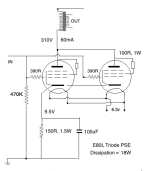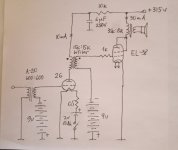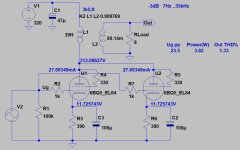I’ve written about this on other threads, and others have contributed the same idea, so this is just pulling together all our various ideas and experiences. The point of this amplifier is that we don’t put the DHT in the output - no 2a3 or 300b here. We put the DHT in the input. By DHT we mean a typical DHT small signal tube like 26, 01A, 112A, 2P29L, 4P1L, 01A, 47. Mu needs to be 8 or more, though 46 might work with sensitive speakers. Filament bias is preferred, and Rod Coleman regs. The goal here is a 2 stage amp, and could be SE or PP.
The point of putting the DHT first is that this has a big influence on shaping the overall sound and tonality. I abandoned 2a3 and 300b amps out of frustration that whatever indirectly heated tube I put in front of it (6SN7 etc), that was the flavour of the sound I’d get, not the DHT in the output stage. And I wanted the DHT tonality to be the dominant one.
For a SE amp in a typical smallish room playing at moderate levels I have found that an output tube with 18W dissipation and a mu of 18-20 is what is needed. This could be done in PP as an alternative with appropriate phase splitter like an interstage or Mosfet splitter to keep to 2 tube stages. But SE with tubes in triode is good. The choice of output stage starts with PSE choices like a pair of EL84 or equivalent, and particularly E80L which is SQ with gold pins. For a single tube the EL12n is available new and cheap from BTB in Germany. In the USA the 7591 is more common. These all in triode.
So there are several choices of tubes for this Inverted DHT amplifier, all of which highlight the DHT sound in the input. I’ve been using this design for a few years now and find it detailed, transparent and with very nice tonality. My personal input choice is the type 26 with a 39K resistor load, but others may well prefer a 01A with active load, a 47 or a 10Y/801, or to keep it cheap a 2P29L.
So use this thread to post your designs, experiences and ideas! Let's venture beyond the typical 2a3/300b configuration.
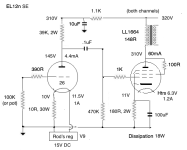
The point of putting the DHT first is that this has a big influence on shaping the overall sound and tonality. I abandoned 2a3 and 300b amps out of frustration that whatever indirectly heated tube I put in front of it (6SN7 etc), that was the flavour of the sound I’d get, not the DHT in the output stage. And I wanted the DHT tonality to be the dominant one.
For a SE amp in a typical smallish room playing at moderate levels I have found that an output tube with 18W dissipation and a mu of 18-20 is what is needed. This could be done in PP as an alternative with appropriate phase splitter like an interstage or Mosfet splitter to keep to 2 tube stages. But SE with tubes in triode is good. The choice of output stage starts with PSE choices like a pair of EL84 or equivalent, and particularly E80L which is SQ with gold pins. For a single tube the EL12n is available new and cheap from BTB in Germany. In the USA the 7591 is more common. These all in triode.
So there are several choices of tubes for this Inverted DHT amplifier, all of which highlight the DHT sound in the input. I’ve been using this design for a few years now and find it detailed, transparent and with very nice tonality. My personal input choice is the type 26 with a 39K resistor load, but others may well prefer a 01A with active load, a 47 or a 10Y/801, or to keep it cheap a 2P29L.
So use this thread to post your designs, experiences and ideas! Let's venture beyond the typical 2a3/300b configuration.

Last edited:
Andy - Great idea to start a thread dedicated to this topology.
Some may recall that I followed Andy's pioneering efforts and built an inverted SET (iSET) a while back which I call the Nuance. I'm using the 26 on the input and the 6N6G for the output tube.
Here are the schematics and a link to the Nuance build thread. I'm looking forward to seeing how others implement this topology.
https://www.audiokarma.org/forums/index.php?threads/the-nuance-my-inverted-set-diy-project.990205/


Some may recall that I followed Andy's pioneering efforts and built an inverted SET (iSET) a while back which I call the Nuance. I'm using the 26 on the input and the 6N6G for the output tube.
Here are the schematics and a link to the Nuance build thread. I'm looking forward to seeing how others implement this topology.
https://www.audiokarma.org/forums/index.php?threads/the-nuance-my-inverted-set-diy-project.990205/
I don't want to be devil's advocate, but the direction of the design is not completely correct.
As I wrote in another thread "from the back to the front" is the better approach.
If you know the desired power (enough for your speakers and listening habit/practice) and satisfactory -hypothetical- DF, the OPT and power device's output impedance can be selected.
For specified (power, impedance ratio) OPT several power device choosable, with various operating point (for selected power), taking into account the primary -maximum- current.
If you select the power device (for example tube), the driving of this device can be calculated (the most simple method is datasheet curves).
If you know the driving parameters (swing, perhaps grid current, calculated/guessed driver output impedance), the driver stage can be planned (with can be planned overhead).
If you know the driver stage output criteriums, can be selected the corresponding driver device (considering the available input volume).
This is the design method of all amplifier.
IMHO ... but I'm just an engineer. 😈
As I wrote in another thread "from the back to the front" is the better approach.
If you know the desired power (enough for your speakers and listening habit/practice) and satisfactory -hypothetical- DF, the OPT and power device's output impedance can be selected.
For specified (power, impedance ratio) OPT several power device choosable, with various operating point (for selected power), taking into account the primary -maximum- current.
If you select the power device (for example tube), the driving of this device can be calculated (the most simple method is datasheet curves).
If you know the driving parameters (swing, perhaps grid current, calculated/guessed driver output impedance), the driver stage can be planned (with can be planned overhead).
If you know the driver stage output criteriums, can be selected the corresponding driver device (considering the available input volume).
This is the design method of all amplifier.
IMHO ... but I'm just an engineer. 😈
Hello Bela
As you may have guessed, I don't see it this way. I have found through numerous builds of 2a3 and 300b amps followed by numerous builds of inverted DHT amps spanning several years, that putting the DHT first gives the most benefit to the DHT sound. I don't doubt my ears on this.
But why is it not possible, as you say, to start by saying "if we select a high gain triode as output tube, then what would the optimum driver stage be?" and conclude that it would be a DHT? We still get to the same end point.
The end point of a high gain indirectly heated triode driving a 2a3 or 300b in a 2 stage amp is not an end point I have any further interest in. I don't doubt that this inverted design works. I built a copy of my personal SE amp for a friend and he immediately sold his 300b amp. Just one example, but that's what happened. I explained the design to another audio friend and his only question was "What took you so long?' The only answer I could think of was "because I always assumed you had to put the DHT in the output since these were the only schematics I was familiar with". And this is mainly because commercial designs use currently available tubes, therefore input stages with the likes of 12AX7 and 6922. Which to my ears sound like 12AX7a or 6922s. It took me years to break out of the mould, but I'm very glad I did.
As you may have guessed, I don't see it this way. I have found through numerous builds of 2a3 and 300b amps followed by numerous builds of inverted DHT amps spanning several years, that putting the DHT first gives the most benefit to the DHT sound. I don't doubt my ears on this.
But why is it not possible, as you say, to start by saying "if we select a high gain triode as output tube, then what would the optimum driver stage be?" and conclude that it would be a DHT? We still get to the same end point.
The end point of a high gain indirectly heated triode driving a 2a3 or 300b in a 2 stage amp is not an end point I have any further interest in. I don't doubt that this inverted design works. I built a copy of my personal SE amp for a friend and he immediately sold his 300b amp. Just one example, but that's what happened. I explained the design to another audio friend and his only question was "What took you so long?' The only answer I could think of was "because I always assumed you had to put the DHT in the output since these were the only schematics I was familiar with". And this is mainly because commercial designs use currently available tubes, therefore input stages with the likes of 12AX7 and 6922. Which to my ears sound like 12AX7a or 6922s. It took me years to break out of the mould, but I'm very glad I did.
Last edited:
<< I thought 10y 2a3 was your favorite Andy? >>
I love both of these tubes, but alas they don't make a 2 stage amp. What I had to do was put a 1:4 step-up transformer in front of the 10Y. Although it was good, I found that taking away the step-up and substituting a high gain output tube gave me a more transparent sound. I'd willingly use a 10Y input tube instead of my usual 26 but I've become attached to vocals through the 26. Vocals were always the special quality of the 26.
I love both of these tubes, but alas they don't make a 2 stage amp. What I had to do was put a 1:4 step-up transformer in front of the 10Y. Although it was good, I found that taking away the step-up and substituting a high gain output tube gave me a more transparent sound. I'd willingly use a 10Y input tube instead of my usual 26 but I've become attached to vocals through the 26. Vocals were always the special quality of the 26.
Have only tried 6j5 driving a 45 myself. And the vocals of the 45 I love. My dreame is that Emission Labs would make a low power equivalent to the 20A that would fit the 45. 😉
<< Have only tried 6j5 driving a 45 myself. And the vocals of the 45 I love. My dreame is that Emission Labs would make a low power equivalent to the 20A that would fit the 45. 😉
Would it be possible with sensitive speakers to use a 12B as output tube, driven by a DHT like 10Y or 26? It needs a 8K SE OPT, though. I don't know these tubes at all, except that they're not cheap. This would be an expensive solution.
http://www.emissionlabs.com/datasheets/EML-12B-20A-20B-30A.html
Would it be possible with sensitive speakers to use a 12B as output tube, driven by a DHT like 10Y or 26? It needs a 8K SE OPT, though. I don't know these tubes at all, except that they're not cheap. This would be an expensive solution.
http://www.emissionlabs.com/datasheets/EML-12B-20A-20B-30A.html
I agree that in a non-feedback amp, the driver stage is essentially acting like a preamp and we all know the preamp can influence the sound significantly. I'm at a point that I even prefer solid state power amp but I insist on tube preamps.The point of putting the DHT first is that this has a big influence on shaping the overall sound and tonality. I abandoned 2a3 and 300b amps out of frustration that whatever indirectly heated tube I put in front of it (6SN7 etc), that was the flavour of the sound I’d get, not the DHT in the output stage. And I wanted the DHT tonality to be the dominant one.
Here is my take on it. The output tube is EL-38 in triode, mu about 16, so doesn't need much driving voltage. The driver, 26, is run at its max voltage for lowest distortion. Its filament is powered by a 2 V 15 Ah lead acid battery; (3x Gates Cyclone 5 Ah). The recharging circuit is not shown. Fixed bias for both stages is from standard 9V batteries, permanently connected.. The interstage transformer is bifilar, which anyone with an electric drill can wind. Output power is about 5 W.
Edit: this circuit can be made single stage by replacing the first stage with a quality step-up input transformer.
Edit: this circuit can be made single stage by replacing the first stage with a quality step-up input transformer.
Attachments
Last edited:
I've used EL38 in triode and it's a very good sound and a good choice. A little under mu=18 but should still work with most systems. There are quite a few choices for the output tube and this is indeed one. Nice circuit.
I can't quite see the reasons why this topology isn't used more, except for sticking to convention.
1. High gain output tubes are not unusual. The EL84 in triode (mu=20) has been used successfully in numerous amplifiers, including in SE and PSE.
2. DHT small tubes are popular here with DIY tube builders, plenty of threads on 4P1L, 26, 2P29L.
All you have to do is put them together. Easily available tubes, easy build.
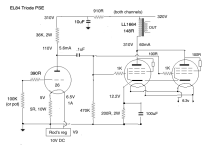
1. High gain output tubes are not unusual. The EL84 in triode (mu=20) has been used successfully in numerous amplifiers, including in SE and PSE.
2. DHT small tubes are popular here with DIY tube builders, plenty of threads on 4P1L, 26, 2P29L.
All you have to do is put them together. Easily available tubes, easy build.

Last edited:
hello Andy:
I think the trick to parallel output tubes is in keeping them balanced and identical. I would be inclined to put separate cathode resistors on them with an adjustable R on each to fine tune the current draw to keep them equal. Of course all passive components need to be closely matched as well.
The choice of the output tube determines the power potential. The design of the output stage/transformer combo can be optimized to minimize H2 expression as well.
Staying with SE amps should also keep the higher order distortion low.
I firmly agree the preAmp/Drivetube can be chosen and set up to adjust the H2 expression from minimal to maximal depending on the desired outcome.
Sorry no designs just musings and thoughts for now.
Good luck with your new direction for audio adventures.
I think the trick to parallel output tubes is in keeping them balanced and identical. I would be inclined to put separate cathode resistors on them with an adjustable R on each to fine tune the current draw to keep them equal. Of course all passive components need to be closely matched as well.
The choice of the output tube determines the power potential. The design of the output stage/transformer combo can be optimized to minimize H2 expression as well.
Staying with SE amps should also keep the higher order distortion low.
I firmly agree the preAmp/Drivetube can be chosen and set up to adjust the H2 expression from minimal to maximal depending on the desired outcome.
Sorry no designs just musings and thoughts for now.
Good luck with your new direction for audio adventures.
<< Sorry no designs just musings and thoughts for now.
Musings and thoughts are where designs begin!
Good point about individual cathode resistors. I used a common resistor with the PSE E80L output stage I built. Worked OK but could maybe work better if tweaked. I use a common cathode bypass cap, DC Link.
PSE EL84s are a simple and widely available way to do this, though there are a few kinds of single tubes that also can be used like EL12n and 7591.
Musings and thoughts are where designs begin!
Good point about individual cathode resistors. I used a common resistor with the PSE E80L output stage I built. Worked OK but could maybe work better if tweaked. I use a common cathode bypass cap, DC Link.
PSE EL84s are a simple and widely available way to do this, though there are a few kinds of single tubes that also can be used like EL12n and 7591.
I have used triode-strapped 6P41S in PSE, they are very linear, but require a big voltage swing on the grids, which will probably be difficult to achieve with a DHT input stage.
You made the right choice, IMHO. 2A3, 300B, 801a are very good but the 45 is one step above. In all configurations: SE, PSE and PP. You don't necessarily need a DHT driver, just a good driver.😉Have only tried 6j5 driving a 45 myself. And the vocals of the 45 I love. My dreame is that Emission Labs would make a low power equivalent to the 20A that would fit the 45. 😉
Great stuff Andy - it’s interesting that my thoughts have also taken me to PSE EL84 with DHT input. I’ll watch this thread with interest.
- Home
- Amplifiers
- Tubes / Valves
- The Inverted DHT Amplifier
